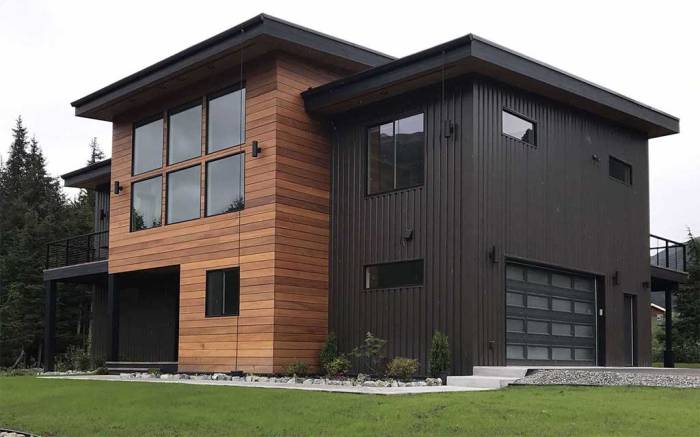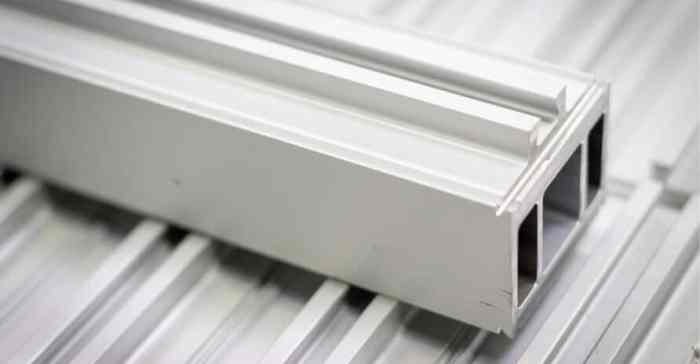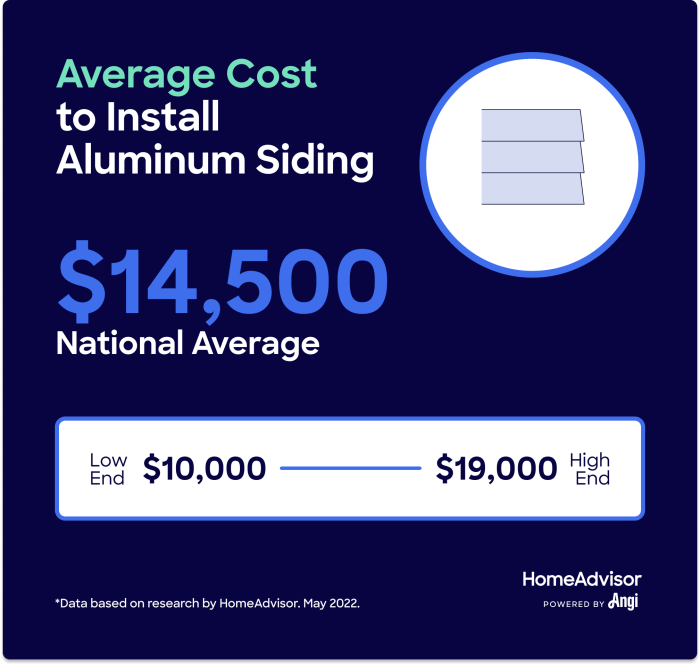Aluminum siding cost is a significant factor in any home renovation project. Understanding the various components that contribute to the final price—from material selection and installation complexity to regional labor rates—is crucial for budgeting and planning. This guide delves into the intricacies of aluminum siding costs, providing a detailed breakdown to help you navigate this often-complex process and make informed decisions.
We’ll explore the key factors influencing the cost, including material quality, thickness, color, and installation complexity. We’ll also examine labor costs, regional variations, and potential hidden expenses. By the end, you’ll have a clear understanding of how to estimate your total project cost and obtain accurate quotes from contractors, ensuring a smooth and financially responsible renovation.
Factors Influencing Aluminum Siding Cost
The price of aluminum siding is influenced by a variety of factors, extending beyond simply the square footage of your home. Understanding these variables is crucial for accurate budgeting and informed decision-making during your home improvement project. This section details the key elements that contribute to the overall cost.
Material Quality and Price
Higher-quality aluminum siding generally translates to a higher initial cost. This is due to several factors including thicker gauge aluminum, superior paint finishes that offer better fade resistance and longevity, and enhanced manufacturing processes that result in a more durable and aesthetically pleasing product. Lower-grade materials may appear cheaper upfront, but often require more frequent repairs or replacement, negating any initial cost savings in the long run. Investing in a premium product often represents a better value proposition over its lifespan.
Siding Thickness and Gauge
Aluminum siding thickness is measured in gauge, with lower gauges indicating thicker material. A thicker gauge (e.g., .032 inch or .040 inch) generally means greater durability, resistance to dents and damage, and a longer lifespan. Thicker gauges naturally cost more than thinner gauges (e.g., .024 inch). The difference in price can be significant, particularly for larger homes or projects with complex designs. For example, a .040 gauge siding might cost 20-30% more than a .024 gauge, but its increased longevity could save money on repairs and replacements over time.
Color and Finish Costs, Aluminum siding cost
The color and finish you choose also impact the final price. Standard colors are typically less expensive than custom or specialty colors. Similarly, finishes like baked-on enamel, which offer superior protection against fading and weathering, tend to be pricier than simpler finishes. Premium finishes with added features, such as enhanced UV protection or textured surfaces, will command a higher price. For instance, a deep, rich color might cost 10-15% more than a basic neutral shade due to the more complex pigmentation process required.
Installation Complexity and Cost
The complexity of the installation process significantly affects the final cost. Factors such as the home’s architecture (e.g., numerous dormers, intricate trim details), the presence of obstacles (e.g., trees, difficult terrain), and the need for specialized techniques (e.g., working around existing structures) all add to labor costs. A simple, rectangular home with straightforward siding installation will naturally cost less than a multi-story home with complex angles and architectural features. For example, a home requiring significant removal of existing siding and extensive prep work could see installation costs increase by 25-50% compared to a straightforward installation.
Aluminum Siding Brand Comparison
The following table compares the cost and features of various aluminum siding brands. Note that prices are approximate and can vary based on location, dealer, and specific product features.
| Brand | Price Range (per sq ft) | Features | Warranty |
|---|---|---|---|
| Alcoa | $2.50 – $4.50 | Various colors, thicknesses, and finishes; known for durability | Variable, check with specific product |
| Mastic | $2.00 – $4.00 | Wide range of styles and colors; good value | Variable, check with specific product |
| CertainTeed | $2.50 – $5.00 | Premium options available; strong warranty | Variable, check with specific product |
| LP SmartSide (engineered wood, for comparison) | $3.00 – $6.00 | Engineered wood siding, offers a different aesthetic | Variable, check with specific product |
Labor Costs Associated with Aluminum Siding Installation

Aluminum siding installation involves more than just materials; a significant portion of the total cost stems from labor. Understanding these labor costs is crucial for accurate budgeting and realistic project planning. Factors such as installer experience, geographical location, and project complexity all play a role in determining the final price.
Hourly Rates for Professional Installers
Hourly rates for professional aluminum siding installers vary considerably depending on factors such as experience, location, and demand. Experienced installers with proven track records often command higher rates than less experienced ones. Generally, expect to pay anywhere from $40 to $80 per hour, though rates in some regions or for specialized work could exceed this range. For instance, a highly skilled installer in a high-cost-of-living area might charge closer to $100 per hour, while a less experienced installer in a rural area might charge closer to $30 per hour. These rates are often influenced by local market conditions and the prevailing wage for skilled tradespeople.
Geographical Variation in Labor Costs
Labor costs are not uniform across the country. Areas with a high cost of living, such as major metropolitan areas on the coasts, typically have higher labor rates than more rural areas. For example, installing aluminum siding in New York City will likely be more expensive than in rural Nebraska, reflecting differences in both the cost of living and the demand for skilled labor. This geographical variation should be factored into your budget, as it can significantly impact the overall project cost. Researching local labor rates for your specific area is essential for accurate cost estimation.
Impact of Project Size on Labor Expenses
The size and complexity of the project directly influence labor costs. Smaller projects, such as siding a single-story shed, require less labor and thus have lower labor expenses. Larger projects, such as siding an entire two-story house with intricate details, require more time and labor, leading to substantially higher costs. While the material costs might scale relatively linearly with project size, labor costs can increase disproportionately due to factors like mobilization, scaffolding requirements, and increased coordination needs for larger crews.
Additional Labor Costs: Demolition and Site Preparation
Beyond the actual siding installation, additional labor costs can arise from necessary preparatory work. This includes tasks such as removing existing siding (demolition), repairing underlying sheathing, and preparing the surface for the new siding. These preparatory tasks can significantly add to the overall labor costs, potentially increasing the total labor bill by 20% or more, depending on the condition of the existing structure and the extent of necessary repairs. Proper assessment of the condition of the existing siding is critical for accurate cost estimation.
Potential Hidden Labor Costs
It’s crucial to anticipate potential hidden labor costs that might not be immediately apparent. These costs can significantly inflate the final bill if not properly accounted for.
- Unexpected repairs: Discovering rotted wood or damaged sheathing during demolition requires additional time and labor for repairs.
- Waste disposal: Proper disposal of old siding and other construction debris incurs additional costs.
- Travel time: Installers might charge for travel time to and from the job site, especially for remote locations.
- Permitting and inspections: Obtaining necessary permits and scheduling inspections can add to the labor costs, as it requires time spent by the installer on administrative tasks.
- Scaffolding and equipment rental: For multi-story buildings, scaffolding rental and setup add to the overall labor cost.
Material Costs Beyond Siding Panels

Aluminum siding installation involves more than just the panels themselves. A comprehensive budget must account for various accessories and preparatory work, significantly impacting the overall project cost. Failing to factor in these additional expenses can lead to unforeseen budget overruns and project delays. This section details the cost of these crucial components.
Accessory Costs
Beyond the siding panels, several essential accessories contribute to the final cost. These items ensure proper installation, weatherproofing, and the longevity of the siding. Their prices vary based on material quality, quantity needed, and regional market conditions. The following table provides estimated costs, keeping in mind these variations are possible.
| Item | Estimated Cost |
|---|---|
| Aluminum Trim (e.g., corner, J-channel, window/door trim) | $1 – $5 per linear foot |
| Flashing (for windows, doors, and other penetrations) | $2 – $10 per linear foot |
| Fasteners (nails, screws, etc.) | $0.10 – $0.50 per fastener (depending on type and quantity) |
| Caulk and Sealants | $10 – $30 per tube (depending on type and size) |
| Underlayment (house wrap or felt paper) | $0.50 – $2 per square foot |
Insulation Costs
The type of insulation used beneath aluminum siding influences both the cost and the overall energy efficiency of the project. While aluminum siding itself doesn’t provide significant insulation, adding insulation significantly improves the home’s thermal performance.
Different insulation types have varying price points. Fiberglass batt insulation is generally the most affordable option, ranging from $0.50 to $2 per square foot. Spray foam insulation offers superior performance but comes with a higher price tag, typically ranging from $1 to $3 per square foot. Rigid foam insulation boards are another alternative, costing between $0.75 and $2.50 per square foot, offering a balance between cost and performance. The choice depends on budget and desired insulation level. For example, a 1500 sq ft home might see a $750-$3000 difference in insulation costs alone depending on the chosen material.
Wall Surface Preparation Costs
Preparing the existing wall surface is a crucial step that significantly affects the final cost. The condition of the existing siding or wall dictates the necessary steps and associated expenses.
Removing old siding adds considerable expense. Labor costs for this process are substantial, and disposal fees for the removed material also contribute to the overall cost. Repairing damaged sheathing or adding new sheathing further increases expenses. For instance, replacing rotted wood sheathing on a 1000 sq ft home could easily cost $2000-$5000 depending on labor and material costs in a specific region. In contrast, cleaning and preparing existing sound siding for new aluminum siding is significantly less expensive. This often involves power washing and minor repairs, resulting in a much lower cost.
Cost-Saving Material Options
Cost-effective options exist without compromising quality. Choosing less expensive but still durable aluminum siding panels can lower the initial cost without sacrificing longevity. Opting for standard trim and flashing instead of ornate designs can also significantly reduce expenses. Using fiberglass batt insulation instead of spray foam can also lower the insulation cost, though it might slightly reduce energy efficiency. Purchasing materials in bulk from reputable suppliers can also result in cost savings. Finally, carefully planning the project and minimizing waste can significantly reduce overall material costs.
Estimating the Total Project Cost
Accurately estimating the total cost of an aluminum siding project is crucial for successful budgeting and project management. This involves a methodical approach encompassing material costs, labor expenses, and a contingency buffer for unforeseen issues. Failing to account for all these factors can lead to significant budget overruns and project delays.
A Step-by-Step Method for Calculating Total Cost
Calculating the total cost requires a systematic approach. First, determine the square footage of the house’s exterior walls needing siding. Next, obtain quotes for both materials and labor from at least three reputable contractors. These quotes should detail the cost per square foot for the siding itself, as well as the labor costs for installation, including preparation, removal of existing siding (if applicable), and cleanup. Add the material and labor costs together to obtain a preliminary total. Finally, add a contingency amount (typically 10-15% of the preliminary total) to cover unexpected expenses, such as material damage, unforeseen repairs, or permit fees.
Realistic Cost Estimates for Different-Sized Homes
Cost estimates vary significantly based on home size and complexity. For a 1,500 square foot home, a reasonable estimate might range from $10,000 to $18,000, while a 3,000 square foot home could cost between $20,000 and $36,000. These figures are broad ranges and depend heavily on factors like siding quality, labor rates in the region, and the extent of necessary preparation work. A simple, single-story home will generally be less expensive than a multi-story home with intricate architectural details. For instance, a Cape Cod style home with simple lines would likely cost less than a Victorian home with many gables and decorative features.
Accounting for Unexpected Costs and Contingencies
Unexpected costs are common in home improvement projects. These can include: discovering rotted wood under the existing siding requiring repair before installation; needing additional materials due to inaccurate measurements; unexpected delays causing increased labor costs; or encountering unforeseen permitting requirements. A contingency fund, typically 10-15% of the estimated project cost, is essential to absorb these shocks and prevent project delays or budget overruns. For example, a $15,000 project should include a contingency of $1,500 to $2,250.
Tips for Obtaining Accurate Quotes from Contractors
Obtaining accurate quotes requires careful preparation and communication. Provide contractors with detailed plans or measurements of the house’s exterior. Request itemized quotes detailing materials and labor costs separately. Compare at least three quotes, paying close attention to the specifics of each proposal. Verify contractor licensing and insurance. Ask for references and check online reviews. Clarify any unclear aspects of the quotes before signing a contract. Finally, ensure the contract clearly Artikels payment schedules, completion timelines, and warranty information.
Sample Cost Estimate Spreadsheet Structure
A cost estimate spreadsheet should be organized for clarity and ease of comparison. It should include columns for: Description of item (e.g., materials, labor, permits), Quantity, Unit Cost, Total Cost, and a final column for a running total. Separate sections can be created for materials (siding panels, trim, fasteners), labor (preparation, installation, cleanup), permits and inspections, and contingency. This structured approach allows for easy tracking of expenses and comparison of quotes from different contractors. The spreadsheet should clearly identify the total estimated cost, including the contingency buffer.
Visual Representation of Cost Breakdown: Aluminum Siding Cost

Visual aids effectively communicate the complex cost structure of aluminum siding installation. Understanding the proportion of material, labor, and other associated costs is crucial for accurate budgeting. The following representations provide a clear picture of these cost components.
Pie Chart Illustrating Cost Breakdown
A pie chart offers a straightforward visualization of the percentage allocation of the total project cost. Imagine a circle divided into three segments: one representing the cost of materials (aluminum siding panels, fasteners, flashing, etc.), another representing labor costs (including installation, preparation, and cleanup), and a final segment encompassing other costs (permits, waste disposal, potential unforeseen expenses, etc.). For a typical project, the material cost might constitute approximately 40% of the total, labor costs around 45%, and other expenses making up the remaining 15%. The relative sizes of these segments visually highlight the dominant cost factors. The specific percentages will vary depending on factors like project size, location, and chosen contractor.
Bar Graph Comparing Aluminum Siding Costs to Other Materials
A bar graph allows for a direct comparison of aluminum siding costs against alternatives such as vinyl and wood siding. The horizontal axis would list the siding materials (aluminum, vinyl, wood), while the vertical axis would represent the cost per square foot. The bars would visually represent the cost differences. For instance, a bar graph might show that aluminum siding costs slightly more than vinyl siding but significantly less than wood siding, reflecting the different material costs and installation complexities. The exact values would depend on regional pricing and material availability.
Graph Illustrating Cost Changes Based on Square Footage
A line graph best depicts how the total cost of aluminum siding installation changes with the square footage of the house. The horizontal axis would represent the house’s square footage, ranging from, for example, 1000 to 4000 square feet. The vertical axis would represent the total project cost in dollars. The graph would show a positive linear relationship, meaning that as the square footage increases, so does the total cost. The line would not be perfectly straight due to economies of scale – larger projects might experience slightly lower per-square-foot costs due to bulk material purchasing and potentially more efficient labor allocation. For example, a 1000 sq ft house might cost $10,000, while a 2000 sq ft house might cost $18,000, illustrating the non-perfectly linear but generally upward trend. Data points could be plotted and connected to visually represent this relationship. This visualization allows for quick estimation of project costs based on the house size.
Successfully navigating the world of aluminum siding costs requires careful consideration of numerous variables. From the initial material selection and the intricacies of installation to the often-overlooked additional expenses, a comprehensive understanding is paramount. This guide has equipped you with the knowledge to accurately estimate your project cost, compare quotes effectively, and make informed decisions that align with your budget and expectations. Remember, proactive planning and thorough research are key to a successful and cost-effective aluminum siding installation.
Expert Answers
What is the average lifespan of aluminum siding?
Aluminum siding typically lasts 30-50 years, making it a durable and long-term investment.
Can I install aluminum siding myself?
While possible, professional installation is highly recommended for optimal results and warranty coverage. DIY installation can lead to mistakes that compromise the siding’s longevity and aesthetics.
Does aluminum siding require much maintenance?
Aluminum siding is relatively low-maintenance. Regular cleaning with soap and water is usually sufficient to keep it looking its best.
How does climate affect aluminum siding cost?
Extreme climates might influence material choices (e.g., thicker gauge for harsher conditions), impacting overall cost. Labor costs may also vary regionally.
Are there financing options available for aluminum siding installation?
Many contractors offer financing plans, or you may explore home improvement loans through banks or credit unions.


